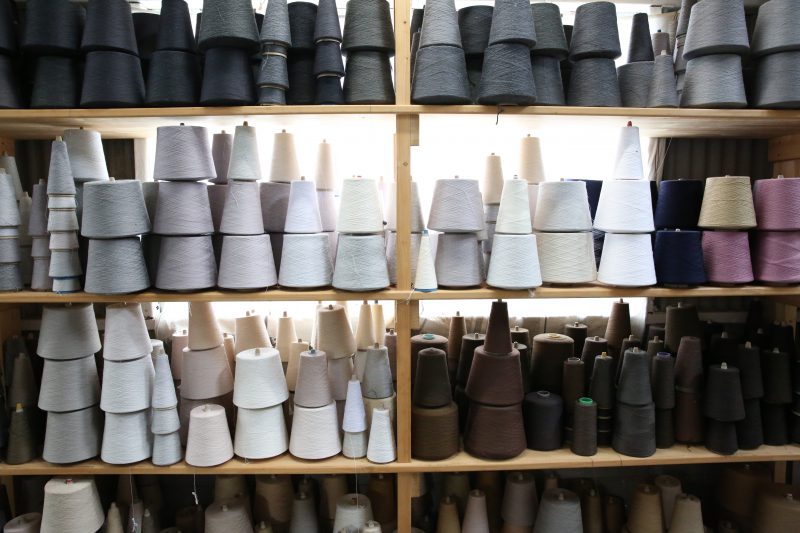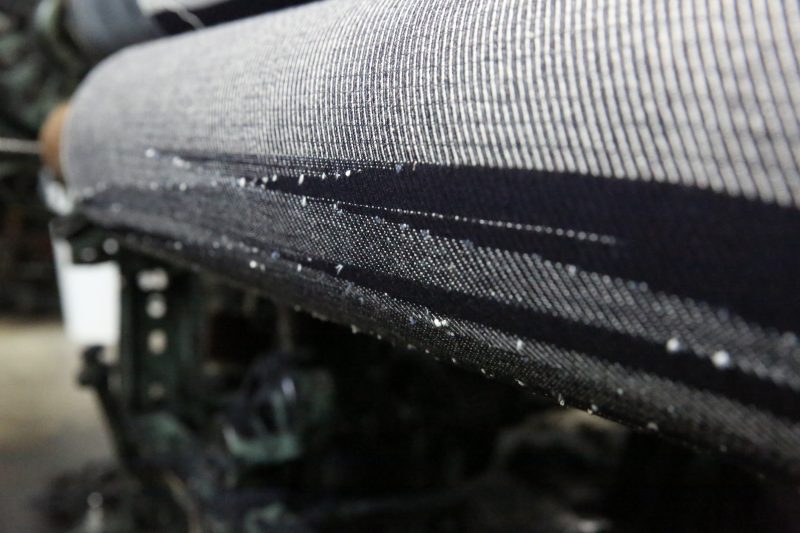niime 百科
Encyclopedia of niime
niime史 第6回
ジャッジする、シナリオを描く。
niime History Chapter 6
Evaluate, then Create a Workflow.
ジャッジする、シナリオを描く。
Evaluate, then Create a Workflow.

2019 . 05 . 15
tamaki niimeというブランドの進み方やイベントの打ち出しからは、そのモノづくりと同様に、シャープな判断に基づき綿密にデザインされた筋書きと、常に受け手をあっと驚かせる様な仕掛けが用意されていると感じる。
今、スタッフの間ではtamaki niimeらしさを問いつつ、それをベースにチームとして新たなモノづくりのディスカッションが繰り広げられ、“niimeイズム”が継承され始めている。
顧客と向き合い、買い求められた作品たちが身に付けられ使われてゆくその先にまで想像を及ばせ、シナリオを描こうとする独自のモノづくりと販売のアプローチについて玉木が語る。
時間と労力を無駄に使わない
小学生の頃、パズルとかにすごくハマってた時期があったんですけど、時間を無意味なことにかけるのはやめようと思ったことがあるんです。最初の頃のパズルは親が買って来てくれたアニメだとか可愛いらしい系のやつで、組み立てるのが好きですごく楽しいんだけど、部屋に飾りたく無いんですよカッコ良くはないから。で、壊してまた組み立てるんだけど飽きてきちゃうから、結局それはゴミになっちゃうんですよね。でも、どうせやるんだったら、部屋に飾りたいと思うような写真のにしたらいいじゃんと思って白黒の、マリリン・モンローだったかな?白黒だから難しくて組み立てに無茶時間がかかったけど(笑)、そうゆうのを飾ったりすると、価値があるというか、やったことがちゃんと“作品”になる、それでゴミにもならないしと思って。そんな風だったから何でものめり込むタイプだけど、後でやらなきゃよかったって思うんだったら、もう最初からやらない方が良いなとなったんですよ。
やるべきことに優先順位をつける
だから仕事においてもすごく学びになってるのが、本当に今やるべきことかどうか?っていうジャッジをすること。スタッフ観てても一生懸命な人はホント一生懸命だし、無茶頑張る人は長時間フルスピードで頑張るんだけど…“強弱”がない。仕事に優先順位がない人が多い。でも、それっていちいち指摘することじゃなくて、自分で自覚しないといけないと思うから。
一人で一日に出来る仕事の量なんて限度が決まっているじゃないですか。ウチが最初3人でスタートした時も、やりたいことはいっぱいある、あれもしてみたいこれもしてみたいと山のようにあるけれども、でも食べて行くためには、結果を出すためにどうゆう優先順位で無駄を省いて何をやるかをしっかり考えたから。先ずショールに絞って、力織機を入れて、ほかと差別化する為にひとつの事をトコトン掘り下げた。それから、いろんな作品を徐々に増やしていこうという順序にした。パンツも欲しかったし、ちゃんとしたシャツも創りたいと思ってたけど、そこを絞り込むことで、時間と自分が出来ることを精査したから今のtamaki niimeがある。今やってることは効率的なのか?無駄じゃないのか?とかは常に考えるようにしている。
シナリオを描いて動く
整理されてないデスクを見ると私が気持ち悪くなるのは、ひとつのものを探すのに無茶時間がかかるでしょう?その時間が無駄だと思うから、どこにハサミは置いてる、どこに鉛筆は置いてるってゆうのがあらかじめわかる状態に常にしておきたいと思うんですよ。仕事自体も優先順位を整理してやるべきだから、やらなきゃいけない仕事が100個あるとして、より結果を出すためには、その100個のうちどの順序でどのタイミングで仕掛けて行くのかが大事だと思うから。ただむやみに動き出すよりも、その辺を“妄想”するのってすごく大事。そこが上手な人が少ないと感じる。それぞれ個々に皆んな頑張ってるんだけど、なんと言うか、“もったいない”って思っちゃう。
効果を生むためには、どの順番でどのように仕事をこなしていくか、このタイミングでこれを差し込んで、次のタイミングではこれをやるから効果が倍になるとか3倍になるとか、このお客様には今このタイミングでこの言葉をかけるから納得してもらえるとか。全部シナリオを書いてから動かないと。同じことをやっても意味が無ければ仕方ないから。
チームによるモノづくりの可能性
今はtamaki niimeもすごくスタッフの人数が増えて、いろんなチームが出来て、各チームがそれぞれ、tamaki niimeをどうしていったら良いのか?ってことをしっかり議論してくれた上でモノづくりをしていく体制になりつつある。私もまだこれからどうなっていくのか予測は出来ないし、違うだろそれは!ってところは無茶文句言ってる(笑)けど、それはやっぱりtamaki niimeの歴史を知らないがゆえの部分を指摘するだけで、基本的には、「こうでなければいけない」というのはなくそうと思っているんです。
これだけチームになってきたから、それぞれの得意なところを発揮して補い合ってくれればと思うから、多様性のある、いろんな特徴を持ったスタッフを集めなきゃと思っている。例えば販売にこだわる人と創ることにこだわる人がいるとして、お互いが遠慮せずにちゃんと議論ができるなら、あっちもこっちもパーフェクトにこなすことは求めない。だけど、ちゃんとお互いを知るってことは大事だから、インターンみたいにして、創る人でも販売をしてみることとかを実践してもらっています。
創り手もお客様と接する現場に出る
今も「織」チームのメンズが名古屋の百貨店に出張に行ってますけど。私も最初接客もしてたから、創る人であってもお客様と接して、目の前で良いって言って頂ける喜びと、駄目だって言われる哀しみと、両方体験しないと創作意欲って湧かないと思う。それで凹んじゃうことももちろんあるし、たくさんの情報が入り過ぎて私も混乱しちゃった時期もあったんだけど、でも自分だけが身に付けるんじゃなくていろんな人が着るんだから、いろんな人がどういう風に思ってくれてるのか、もっとこうして欲しいという要望があるんだったら、それを実直に聴いて作品づくりに活かすとか…そこからしか始まらない。結局買って下さった方が使って長く身に付けて下さることで私たちのブランドの意味って出て来るから。買うまでじゃなくて、ボロボロになって破れちゃうくらいまで、それをまた何かに使いたくなるくらいの…買って頂いたところから身に付け使ってゆく歴史がスタートするわけだから、そこのスタートする場面をじかに観れるかどうかってすごく大事だなと。そこは、創るスタッフにもどんどん行ってこいって言ってますけど。
やっぱり、一度販売に出るとだいぶ違う。想像の世界と実際リアルに言われる世界と、人を介して教えてもらう情報と直接声を聞くことって。やっぱり感情が伴うから、喜びもひとしおだし、哀しみもひとしお(笑)だと思うので。その辺を体験しつつ、やっぱり求められてるからこそもっと頑張ろう、もっと新しいモノを、もっと柔らかいモノを、もっと品質の良いモノを、という風にスイッチが入ってもらえたら。
去年の新人から今年の新人へ
これだけスタッフがいて“脳”が増えてきたらいろんな発想が出てきて、それもアリだなこれもやってみたらということが出て来るだろうから、そこがすごく期待するところかなと。
いろんな意識を持ったスタッフがどんどん入ってきて、私が出ないチームごとの会議とかもけっこうあるんですけど、かなり白熱して議論してるから良いなと思って。
今夏にある3周年記念イベント「みっつ会」の実行委員会もすでに立ち上がって。あ、もう私が出なくてもちゃんと回り始めたな、とかね。前回新人企画とかやってもらって、その去年の新人の代表が今年の新人チームにオリエンテーションするとかね。去年は私たちはこんなことしたんだよ、あなたたちも頑張りなさいとか言ってるから面白い。“引き継げる”というか。そんな様子が良いなぁと思って。そういう意味じゃ仕事だけど学校みたいな感じもあるなと観てますけどね。まぁ、人生は一生学びだから。
書き人越川誠司
As the tamaki niime brand moves forward, launching promotional events; it seems that much like the art of creation there is a carefully designed workflow based on keen judgement and mechanisms that surprise recipients.
Now, in discovering the uniqueness of tamaki niime, the teams have been having discussions on newer creations, and “niime-isms” are beginning to be passed down.
Facing the consumer’s needs and imagining how they wear them and use them in their hand. Then drawing the use scenario of her creation. Ms Tamaki talks about her unique creating style and distribution process.
Not Spending Time and Effort Wastefully.
When I was in elementary school, I was really into puzzles and decided to stop spending time on meaningless things. When I started doing puzzles, my parents selected for me anime or cute styles. I liked to assemble them, and it was enjoyable. However, I didn’t want to hang them in my room because they didn’t suit it. So, since I didn’t use them for decoration, I restarted all the puzzles, but it got boring quickly. They ended up in the trash. But if I did it anyway, I thought it would be nice to try a photo to decorate, like a black and white Marilyn Monroe? It was challenging to put together without colour, (laugh) but I thought it would have more value that way. It would have value, and wouldn’t be trashed. I used to dive into anything. Later, I realized I’d jumped in without thinking, and it would have been better to not do in the first place.
Prioritizing TODOs
One of the things I learned a lot about, which is useful in work is figuring out what to prioritize. As I observed the staff working, I saw them working harder, and then some working even harder for more extended periods. However, they didn’t seem to get the dynamics. Many of them don’t prioritize their work. That’s not something that I should point out, but I think they should be aware of it by themselves.
I think there must be a limit to the amount of work that one person can do in a day. Don’t you think? When I started our brand, just with the three of us, there were a lot of things I wanted to do. It was like, “I want to do this, and I want to do that, too.” But to survive, I analyzed which ones were a high priority and eliminated any inefficient tasks to get the best results. First, we focused on shawls and introduced power looms to differentiate from other companies. We then ensured that we would put our focus on one thing at a time. Then, we decided to gradually introduce other products at the right time. I wanted pants as one of our brand products, and I wanted to design and create a well-made shirt. By screening my want-to-do list, we scrutinized the time, what we could do, and so we have the current tamaki niime. I always try to keep in mind whether we are being efficient or wasteful.
First, create scenarios. Then make moves.
When I see a cluttered desk, I feel sick. It is because it takes way too long to find anything. Because I think that is such a time-waster, I want things to be kept organized. That way I know where the scissors or pencils are. At work, tasks should be organized and prioritized. If we have 100 tasks, to get the best possible result, I think is to plan where to start, which is the key to successful completion. Rather than just working at random, it is imperative to plan a ‘mental simulation’. I feel that not many of our staff do that well. Each one of them works hard, but how do you say, they don’t utilize their time efficiently.
How to complete most tasks. In what order is necessary to achieve the best outcome. When to start. When is the right moment, which could increase production two to three times the expected result. By assisting this customer at the right moment with the specific phrases, it should help the customer in creating the best shopping experience. All of these are possible scenarios. We must draw the scenarios before making a move. Doing the same old things is wasteful if it does have a positive meaning behind it.
Possibility of creation by team
Currently, tamaki niime has more staff than ever, with various teams. Each team considers the brand direction. Proactive discussions lead to creations based on each team contributions. Even I am unable to predict where our brand is going, and I still give advice or heavily complain (laugh) on things I disagree with. I point that out only because our newer staff do not understand tamaki niime brand history. I simply try to eliminate things that are “it-must-be-like-this”.
Because of our growth into such a large team, I hope each of us will be able to demonstrate our strengths and complement each other. Therefore, I feel the need to gathering a diverse staff with various characteristics. For example, suppose some people are particular about sales and people who are particular about creating. In that case, they can have open discussions with each other, we do not have to ask for everything to be perfect. However, it is essential to have an understanding of each other’s tasks, for example, for interns, we give them opportunities to experience sales, and so on.
Creators also go to interact with our customers.
Our male staff from the “Weave team” are on a business trip to a department store in Nagoya right now. I used to help sales and customer care on sight when I started my brand. So I know that even if you are a creator, it must be hard to keep motivated unless you experience both the joy of being told that you are good and the sadness of being told that you are not acceptable by real customers. Of course, that can make anyone discouraged. There were times when I was also confused because there was too much information from the customer. However, various different people wear them, not just yourself. Listening to what they really feel when wearing them and having an honest understanding of their needs is an education. It all begins from there. After all, the value of our brand comes from the purchaser using and wearing it for a long time. The story doesn’t end at the time of purchase. I want them to be valued and used even after it becomes tattered and torn… The history of a product starts from the point of a customer’s purchase, so I think it must be a fantastic experience for creators to be there at that moment when its history starts. So, I encourage our creative department staff to go on site.
It’s obvious. Experiencing the store sales operation enables them to realize the differences. Between imagination and real voices, or between information that is reported and the information you hear directly from the end-user. Because with real voices, there is emotion in it. It will bring you more joy or more sadness. (laugh) I am hoping the experience will encourage their creative passions, motivating them to try harder. They will know for sure that they need newer, softer things of better quality.
From last year’s rookies to this year’s rookies
Since we have so much more staff and the number of “minds” increases, I am excited to see more variety in exciting ideas coming forth.
More diverse talents have joined our team. There are quite a few team meetings that I do not participate in, but I feel that there is no problem because they seem to be having relatively heated discussions, even without me.
The executive committee of the 3rd-anniversary event “Mittsu-kai” this summer has already been set up. I feel like, “Oh, great! It seems that things are going well without my supervision.” Last time, we let the newbies do a newcomer project, and the representative of the previous year will be oriented to this year’s newcomer team. It was interesting to see that they advised newcomers, “Last year we did something like this. Do your best too.” That has shown that they can “delegate” the task to subordinates. That is wonderful. I observe and feel our work somehow acts as a learning environment, much like a school. Well, I guess life is a never-ending learning journey.
Original Japanese text by Seiji Koshikawa.
English translation by Adam & Michiko Whipple.


